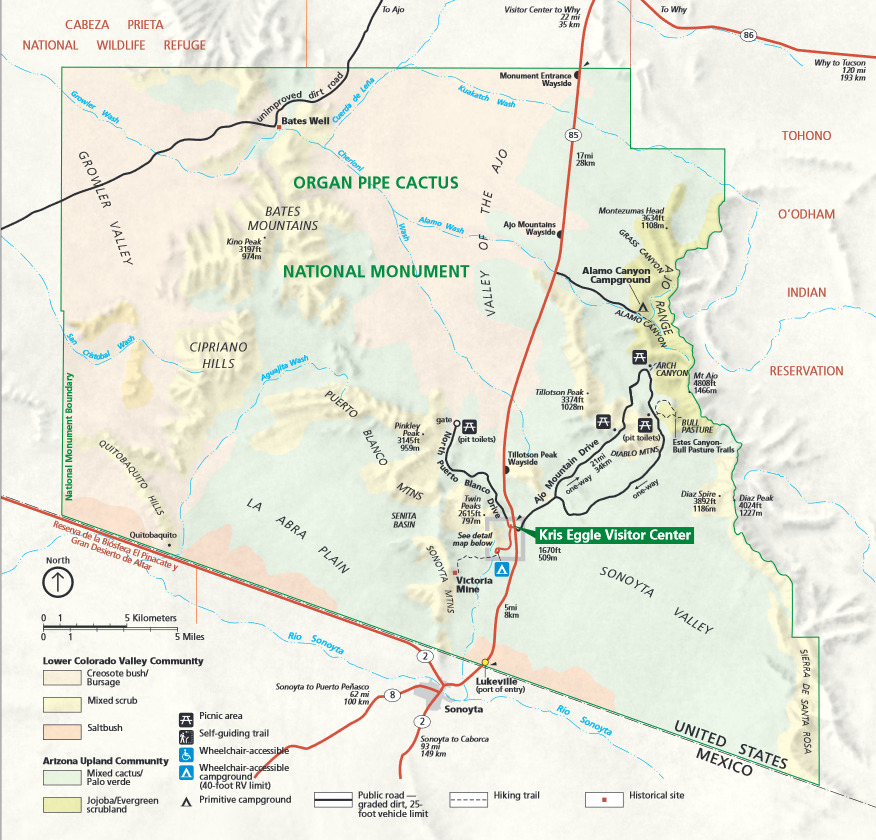Organ Pipe Cactus NM--Bates Well
Organ Pipe Cactus NM--Bates Well
Ajo, Arizona 85321
Official WebsiteOrgan Pipe Cactus National Monument website
Organ Pipe Cactus National Monument map
About this Location
Bates Well Ranch, also commonly referred to as the Bates Well, Growler Well, Gray Ranch, and El Veit, was one of fifteen ranches and line camps established in the Sonoran Desert by the Gray family cattle business in 1935. The ranch was developed and operated by Robert Louis Gray’s son, Henry Gray, from 1935 until his death in 1976. Today, the Bates Well Ranch property serves as a well-preserved example of an early frontier ranching operation. It has been protected under the National Register of Historic Places as a reminder of the significance cattle ranching played in the history of Arizona and the lands that now comprise the Organ Pipe Cactus National Monument.
Bates Well Ranch is situated along the northern edge of Organ Pipe Cactus National Monument in an area that has long been known as an oasis of human habitation within the Sonoran Desert. The Tohono O’odham people, who currently inhabit this region, refer to the Bates Well Ranch area as the “place of saguaro fruit,” for the bountiful harvest of sweet red cactus fruit they collected here each June. Early settlement in the area is evidenced by the discovery of a prehistoric Hohokam Indian encampment and reservoir just a few miles east of Bates Well that is believed to date back to as early as 1000 A.D. While this site has a long history of habitation by various Native American peoples, W. B. Bates is believed to be the first Anglo settler in the region. He dug the original Bates Well, perhaps as early as 1870, and used the site for a simple ore-milling operation.
Bates Well Ranch today remains largely intact and reminiscent of its past when it was owned and operated by Henry Gray as a cattle ranch. The ranch consists of a configuration of corrals, outbuildings, and windmills, along with the main ranch house. The main ranch house was built in 1936 and relocated by Henry Gray from Growler Mine to Bates Well in 1942. The fact that this main ranch house was built strictly from recycled materials adds to its significance in terms of the common frontier practice of living off the land. Resources within the Sonoran Desert were scarce and many frontier families, especially the Grays, were forced to adapt by using any available materials at hand. While other historic ranching complexes and structures exist throughout Arizona, the Bates Well Ranch serves as the most complete and preserved example of early twentieth-century frontier ranching in Arizona.
About Organ Pipe Cactus National Monument
See all hotspots at Organ Pipe Cactus National Monument
President Franklin D. Roosevelt created Organ Pipe Cactus National Monument on April 13, 1937.
Organ Pipe Cactus National Monument was created as a way to preserve a representative area of the Sonoran Desert. The new monument was part of a movement in the National Parks to protect not just scenic wonders but also the ecological wonders of the country.
Organ Pipe Cactus National Monument is the site of cultural resources that reflect long, widespread and diverse occupations by American Indian, Mexican, and European groups. The intersection of these three cultures is significant archaeologically, geographically, and internationally. Evidence of these cultures still remains today, and as you explore the monument, one cannot help but imagine what life was like living in the Sonoran Desert.
Content from Official Website and Organ Pipe Cactus National Monument website
